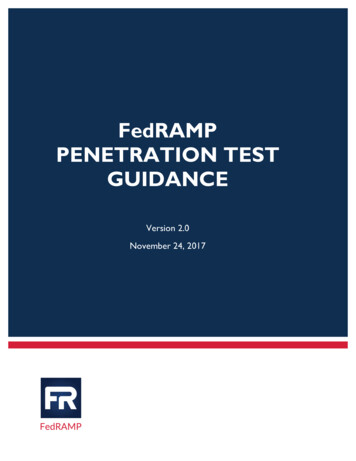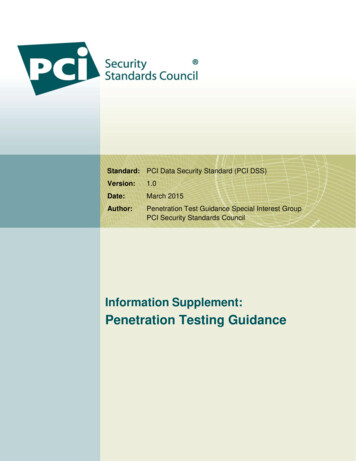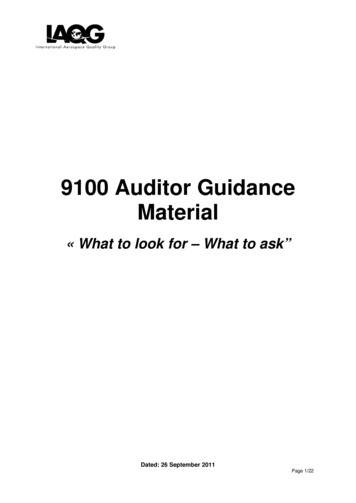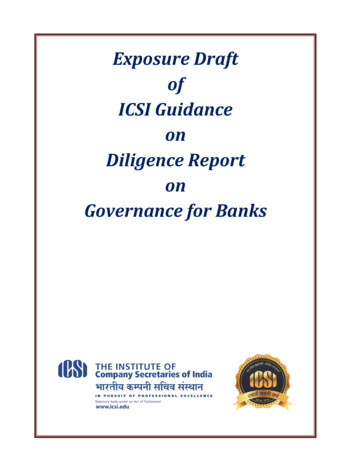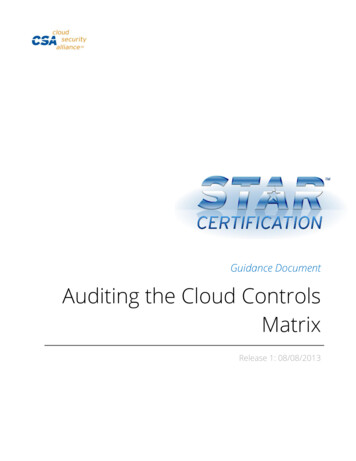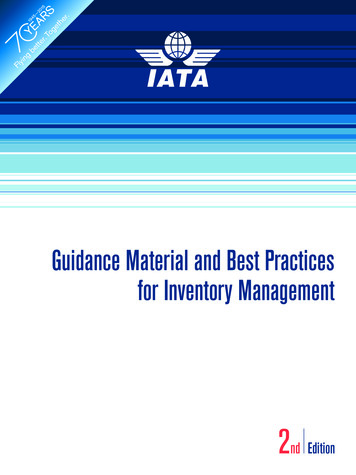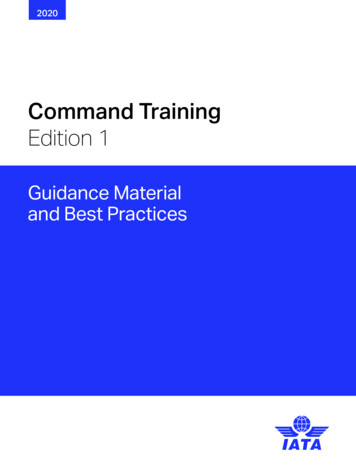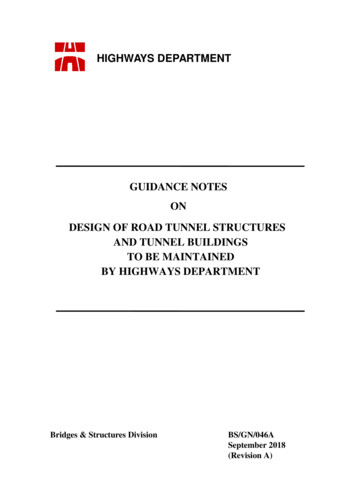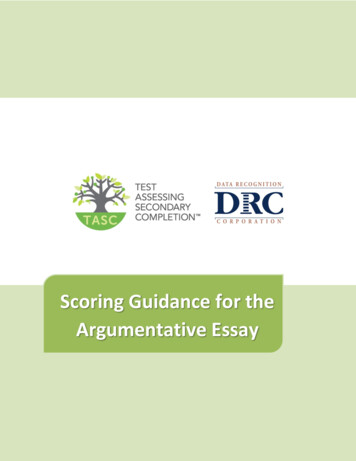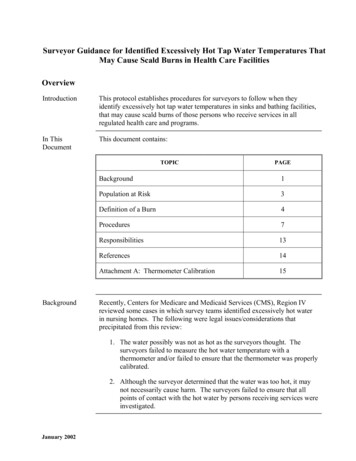
Transcription
Surveyor Guidance for Identified Excessively Hot Tap Water Temperatures ThatMay Cause Scald Burns in Health Care FacilitiesOverviewIntroductionThis protocol establishes procedures for surveyors to follow when theyidentify excessively hot tap water temperatures in sinks and bathing facilities,that may cause scald burns of those persons who receive services in allregulated health care and programs.In ThisDocumentThis document contains:TOPICBackgroundPAGEBackground1Population at Risk3Definition of a chment A: Thermometer Calibration15Recently, Centers for Medicare and Medicaid Services (CMS), Region IVreviewed some cases in which survey teams identified excessively hot waterin nursing homes. The following were legal issues/considerations thatprecipitated from this review:1. The water possibly was not as hot as the surveyors thought. Thesurveyors failed to measure the hot water temperature with athermometer and/or failed to ensure that the thermometer was properlycalibrated.2. Although the surveyor determined that the water was too hot, it maynot necessarily cause harm. The surveyors failed to ensure that allpoints of contact with the hot water by persons receiving services wereinvestigated.January 2002
Surveyor Guidance For Identified Excessively Hot Tap Water Temperatures That May Cause ScaldBurns In Health Care Facilities3. The elderly have special concerns that must be considered beyond thetime/temperature contact with excessively hot water.This protocol is to assist survey staff in assuring that these issues areaddressed in a consistent manner, in any regulated facility/program inwhich potentially hazardous hot water temperatures are identified.Typically, the regulations for most federally certified facilities do not includespecific required hot water temperatures; however, the regulations addressthat the facility/provider must ensure the environmental safety of the personsreceiving services. There is information available regarding thetime/temperature relationship of contact with hot water that can be used asguidance to determine the seriousness of threat of injury to the personsreceiving services.The following are some regulatory requirements for hot water in health carefacilities (this is not all entTemperatureICF/MRYesNoneNot to exceed 110 FNursing HomeNoneYes105 F to 115 FAdult Day CareN/AYes105 F to 115 FHospitalNoneYesNot to exceed 120 FALF*N/AYesNot to exceed 120 FAFCH*N/AYesNot to exceed 120 FRTF*N/AYesNot to exceed 120 FCSU*N/AYesNot to exceed 120 F*These facilities are included in Community Based Residential Facilitiesrule, 64E-12, which is enforced by the Department of Health.According to the 2000 American Burn Association Burn Awareness WeekCampaign, scald burns are preventable. Young children, older adults andpeople with disabilities are most vulnerable to this type of injury. Most burninjuries happen in the home with tap water scalds occurring in the bathroomor other bathing areas. Other scalds relating to preparation or serving of foodJanuary 20022
Surveyor Guidance for Identified Hot Tap Water Temperatures which may cause Scald burns in Health CareFacilitiesoccur in the kitchen. The severity of injury with scalds depends on twofactors: The temperature to which the skin is exposed, and The length of time that the hot liquid is in contact with the skin.At 120 degrees Fahrenheit / 48 degrees Celsius, the recommendedtemperature setting for home water heaters, skin requires five minutes ofexposure for a full thickness burn to occur. When the temperature of a hotliquid is increased to 140 F / 60 C. it takes only five seconds or less for aserious burn to occur1. Coffee, tea, hot chocolate and other hot beverages areusually served at 160 to 180 F. / 71-82 C. degrees, resulting in almostinstantaneous burns that require surgery to heal. Immediate removal of thehot liquid from the skin may lessen severity, therefore splash and spill burnsmay not be as deep as burns to someone who falls into a bathtub.1Moritz, A.R., Herriques, F.C. Jr. Studies of thermal injuries: II The relative importance oftime and surface temperature in the causation of cutaneous burn. Am J Pathol 1947; 23:695720.High RiskPopulation forScald BurnsAlthough anyone can be affected by scalds, certain people are at increasedrisk. These high risk groups include infants and young children, older adultsand people with any type of disability. Males are about twice as likely to bescalded as females in all age groups.Older AdultsOlder adults, like young children, have thinner skin so hot liquids causedeeper burns with even brief exposure. Their ability to feel heat may bedecreased due to certain medical conditions or medications so they may notrealize water is too hot until injury has occurred. Older adults may also haveconditions that make them more prone to falls in the bathtub or shower orwhile carrying hot liquids.People With Disabilities or Special NeedsIndividuals who may have physical, mental or emotional challenges or requiresome type of assistance from caregivers are at high risk for all types of burninjuries including scalds. The disability may be permanent or temporary dueto illness or injury and vary in severity from minor to total dependency onothers. Mobility impairments, slow or awkward movements, muscleweakness or fatigue, or slower reflexes increase the risk of spills whilemoving hot liquids. Burns to the lap are common when a person attempts tocarry hot liquids or food while seated in a wheelchair. Moving hot liquids canbe extremely difficult for someone who uses a cane or walker. Sensoryimpairments can result in decreased sensation, especially to the hands andfeet, so the person may not realize if something is “too hot.” Changes in aperson’s intellect, perception, memory, judgment or awareness may hinder theperson’s ability to recognize a dangerous situation (such as a tub filled withscalding water) or respond appropriately to remove his or herself from danger.January 200213
Surveyor Guidance For Identified Excessively Hot Tap Water Temperatures That May Cause ScaldBurns In Health Care FacilitiesWhile the principles of scald prevention that apply to the general populationalso apply to this high risk group, there are additional concerns that must beaddressed.Scald injuries result in considerable pain, prolonged treatment, possiblelifelong scarring, and even death. The number of deaths from scalds is 100annually in all age groups.Tap water scalds are often more severe than cooking-related scalds.Nationwide, tap water scalds result in more inpatient hospitalizations,generally cover a larger percent of the person’s body, and result in morefatalities than other types of scalds5.For additional information relating to burn prevention, contact the AmericanBurn Association at 800-548-2876 or www.ameriburn.org.Compiled by P. Brigham, Burn Foundation, Allentown, PA, 1999.Sources: National Health Interview Survey, National Hospital Discharge Survey, NationalHospital AmbulatoryMedical Care Survey, National Electronic Injury Surveillance System.Young, M., Manara, A & Burd, D. (1995) Intensive care management of the child with severeburns. Care of the Critically Ill. May-June, 11(3); 93-7.Definition of aCutaneousBurnA burn is damage to the skin and underlying tissue caused by heat, chemicalsor electricity – a very simplistic definition for a very complex injury. Burnsdamage or destroy the skin cells. Deeper burns may involve the fat, muscle orbone. Scalds result from the destruction of one or more layers of the skin dueto contact with hot liquids or steam.The temperature to which the skin is exposed and the length of time the skin isexposed to the burning substance determine the depth of injury. Burns range isseverity from minor injuries that require no medical treatment to serious, lifethreatening and fatal injuries. Burns are categorized in terms of degrees,which are described below. Partial thickness injuries include first and seconddegree burns; full thickness injuries encompass third degree and deeper burns.Superficial (first degree burns) Causes: sunburn, minor scalds Generally heal in 3-5 days with no scarringCharacteristics: Minor damage to the skin Color - pink to red Painful Skin is dry without blistersJanuary 20024
Surveyor Guidance for Identified Hot Tap Water Temperatures which may cause Scald burns in Health CareFacilitiesPartial thickness (second degree) burns Damages, but does not destroy top two layers of the skin Generally heal in 10-21 days Does not require skin graft* Skin is moist, wet and weepy Blisters are present Color - bright pink to cherry red Lots of edema (swelling) Very painfulFull thickness (third degree) burns Destroys all layers of the skin May involve fat, muscle and bone Will require skin graft for healing* Skin may be very bright red or dry and leathery, charred, waxy white,tan or brown Charred veins may be visible Area is insensate - the person is unable to feel touch in areas of fullthickness injury*Except for very small (about the size of a quarter) full thickness burns willrequire a skin graft to heal. The patient is taken to the operating room whereall the dead tissue is surgically removed. Skin is taken or harvested off anunburned or healed part of that person’s body and grafted or transplanted tothe clean burn area. In seven to 14 days, this grafted skin “takes” or adheres tothe area and becomes the person’s permanent skin. The donor site (where theskin was harvested from) is treated like a partial thickness burn and healswithin 1- to 14 days.January 200215
Surveyor Guidance For Identified Excessively Hot Tap Water Temperatures That May Cause ScaldBurns In Health Care FacilitiesLegalAuthorityThe legal authority governing this procedure:Hot Water Temperature RequirementsFacilityState RuleStateSurveyTagFederal F/DDN/AN/A42CFR483.470(d)(3)F426Adult Day Care Centers58A-6.013(8)D1002N/AN/ACommunity BasedResidential Facilities64E-12.003**N/AN/AN/ANursing homesAppendix Q applies to all federally certified facilities.*The federal tag does not include a specific water temperature, but requiresthat the facility ensure the safety of the persons receiving services.**This rule is enforced by the Department of Health.January 20026
Surveyor Guidance for Identified Hot Tap Water Temperatures which may cause Scald burns in Health CareFacilitiesProcedureDetectingexcessively hottap water infacilities.The survey staff are directed to check tap water temperature routinely duringa survey or to investigate a related complaint allegation.The survey staff would check the temperature of the water in resident roomsand shower rooms. This may be done in a random fashion on the tour.For long term care facilities, there are specific references as to whether watertemperatures are safe and comfortable on two of the federal surveyorworksheets. Refer to #6, Hazards on the HCFA-803 (7-95), GeneralObservations of the Facility worksheet, and Section A: Resident RoomReview on the HCFA-805 (7-95), Resident Review Worksheet. Section Aof the Resident Review Worksheet directs survey staff to check watertemperatures for all sampled residents during the survey.The surveyor should hold his/her hand under the running hot tap water fromthe faucet to feel the water. If the water feels hot and/or you notice yourskin turning red, this may be an indication that the water temperatures areexcessively hot.At this point of detection, the survey staff must measure the tap watertemperature immediately with a calibrated thermometer (see Attachment Afor thermometer calibration methods). If the surveyor uses her/his ownthermometer, make certain that the calibration is documented on aworksheet. Also, when ever possible, have another surveyor witness thecalibration procedure.Do not defer this activity for Life Safety Code Surveyor staff, if he/she isnot present on the survey. The Life Safety Code Surveyor staff must benotified if on the survey, but he/she is not solely responsible forinvestigating this situation on the survey, since the risk for the personsreceiving services must be assessed. A surveyor with clinical background,such as a nurse, should assist in the investigation.The type of thermometer most available, appropriate, and practical forchecking the hot water is a dial stem-type food thermometer. Thisthermometer usually has a temperature range from 0 F to 220 F.Dial stem thermometerJanuary 200217
Surveyor Guidance For Identified Excessively Hot Tap Water Temperatures That May Cause ScaldBurns In Health Care FacilitiesDigital thermometers or thermistors should not be used because theseare not to be immersed in water or liquid.Digital thermometerElectronic infrared thermometers are not appropriate for this useeither.Keep in mind that the dial thermometer is accurate to 1 to 2 F, however, itnot precision instrument. The following method explains the use of a dialthermometer: Let the hot water run from the faucet for 3 to 5 minutes Insert the stem straight or at an angle, about 2 inches into the streamof running water. The temperature should register in about 10 to 15 seconds.As the survey staff measures the temperature of the water with thethermometer, they should also hold their hand under the running water atabout the same time to assess for how the water feels on their skin. Makenote if your skin turns red and how long you can endure the heat of thewater, before removing your hand.Several survey staff may be involved in checking hot water temperaturessimultaneously. The survey staff must take temperatures of hot tap waterfrom all possible points of contact, in which persons receiving services maywash their hands or bathe, such as: Sinks in bathrooms Sinks in the bedrooms of persons receiving services Sinks o
Introduction This protocol establishes procedures for surveyors to follow when they identify excessively hot tap water temperatures in sinks and bathing facilities, that may cause scald burns of those persons who receive services in all regulated health care and programs. In This Document This document contains: TOPIC PAGE Background 1 Population at Risk 3 Definition of a Burn 4 Procedures 7 .
